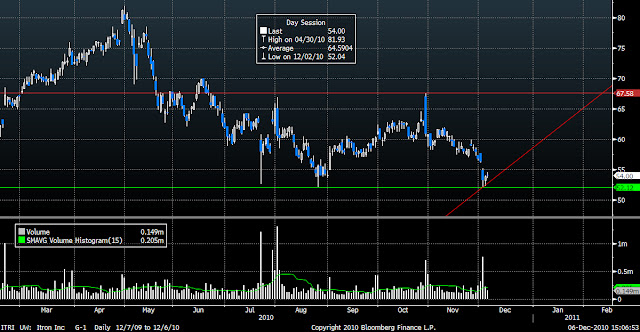This is the second part of a series of posts relating to a thorough analysis of Agrium and what led to conclude that it was a company worth your attention for a further analysis. Part one can be found here.
Agricultural market fundamentals remain strong
As we know, the price of fertilizer is closely related to the price of grains. The cereal harvest reached world record levels in 2008. The United States Department of Agriculture (USDA) estimates that 2,225 million metric tonnes (Mt) were harvested and that cereal inventories went up slightly. The Food and Agriculture Organization of the United Nations (FAO) and USDA estimate that the 2009 cereal crop was 1.5 to 2.0% lower than the 2008 record. Because of the recession, world grain demand will increase only modestly in 2009/10 and the world output would match demand, resulting in relatively stable inventories. Affected by the economic context, crop prices dropped in the second half of 2008 before slightly firming in the first half of 2009. Most international prices for agricultural commodities are currently relatively strong compared to pre-2008 levels.
Global Fertilizer Demand
After years of increasing demand, fertilizer use slowed in 2008. Like other commodities, the worldwide economic downturn is the primary reason for the declining fertilizer use, dropping prices and mounting inventories for the year 2008-2009. World fertilizer consumption seen as dropping 5% in 2008/09, negatively affecting the demand compared with the previous year. Nitrogen has been much less affected, as this nutrient is vital for crop yields. Nitrogen, Phosphorous and Potassium fertilizer demand is estimated to drop by 1.6, 7 and 14%, respectively. The largest contractions in volume are observed in Western and Central Europe, North America and Latin America which, coincidentally, are all of the areas in which
Agrium operates.
Global Fertilizer Supply
The world fertilizer markets experienced a period of huge volatility in 2008 despite strong demand fundamentals. The global economic downturn and tight credit dampened short-term prospects for fertilizer consumption. Fertilizer market conditions worsened considerably in the fourth quarter of 2008 as sales collapsed, driven by weakening financial and economic conditions, tight credit access and, to a certain extent, loss of fertilizer demand or purchase deferral in a large number of consuming countries.
In 2008, global nitrogen production rose by a meagre 1.7% compared with 2007 while the output of phosphate fertilizers and potash declined by 7.5% and 2.8% respectively, due to a drop in exports and weak import demand. Entering 2009, the fertilizer industry was confronted with poor market conditions, marked by lack of sales and weak prospects for production and trade this year. However, stocks of soft commodities and cash crops remain low compared with historical levels. Fertilizer demand will therefore recover, although the pace of recovery is uncertain. The International Fertilizer Industry Association forecasts the balance of supply and demand for the next four years, from 2009 to 2013. For the three main nutrients, Nitrogen, Phosphorous and Potassium the supply is projected to grow at an average annual rate of 6%, 8% and 23% respectively.
Price of inputs
Here is a brief description of a few factors that have an impact on production costs. Because ocean
shipping rates have been in free fall since May 2008, delivery costs have fallen. Energy prices, notably those of crude oil and natural gas, have fallen by more than half compared to their levels in mid-2008, offering some relief to nitrogen producers. However, in the medium term it appears that natural gas prices in key exporting and importing countries may increase again. The cost of sulphur has an impact on the cost of producing phosphorous.
Since Agrium and other companies in the industry operate internationally, currency valuations may affects costs of inputs and price of outputs. Indeed, as a result of the weakening of the Canadian dollar during the fourth quarter of 2008, Agrium experienced significant foreign exchange gains of $98-million.
Important variables for the industry and their business cycle sensitivity
The most important variable that affects fertilizer demand and price is commodity prices such as corn and wheat. Commodity prices affect the farmers’ revenue and thus willingness and ability to pay for fertilizer. The price of corn is currently around $4 per bushel, double its 2005 price of $2. We must note however, that in the summer of 2008 just before the financial crisis, corn peaked at a price of $7.88 per bushel. High commodity prices are an incentive for farmers to plant more, thus increasing the acres of land cultivated. In addition, higher commodity prices increase the farmers’ willingness and ability to pay for fertilizer.
Prospective Demand
With the prevailing strong agricultural market fundamentals and anticipated progressive recovery of the world economy, world fertilizer demand is seen as slightly rebounding in 2009-10 (+3.6%) to 165.4 metric tons, with growth rates of 2.6% for nitrogen, 6.1% for phosphorous and 4.1% for potassium, as it is shown in the table below. Strong recovery is anticipated in East Asia and in Western and Latin America. Consumption would further increase in South Asia and East Asia going into 2013-14. Although slower growth rates than other regions are anticipated for North America and Western Europe, these regions are still expected to expand. Slower growth in these key areas could diminish Agrium’s future performance compared to other foreign firms.
Disclosure: The author has no position in AGU but intends to initiate one in the coming weeks









